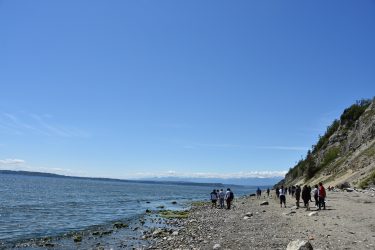
On a clear, windy Saturday morning, a convoy of University of Washington vans weaves through Seattle’s streets and north toward Mukilteo. They load onto a ferry named Tokitae and head west.
Students in Professor Terry Swanson’s Introduction to Geology & Societal Impacts (ESS 101) class are headed to Whidbey Island—Washington state’s largest island and the landmass that forms the northern border of Puget Sound’s waters. This is Professor Swanson’s favorite field excursion of the quarter, because he’s a glacial geologist and Whidbey was formed by glaciers millions of years ago.
A variety of experiences, backgrounds and majors are represented by the students enrolled in ESS 101, but today:
They are all geologists.
Sojourning to Whidbey, one of 10+ field trips offered as part of Earth and Space Sciences‘ ESS 101, gives students an opportunity to explore one of Washington’s most geologically rich field sites up close—complete with glacial erratics, eroding bluffs and layers of sediments and terrestrial deposits.
See what it’s like to be a student in Professor Swanson’s Introduction to Geology & Societal Impacts class, which is offered every quarter, and consider whether this immersive course might be a fit for you.

